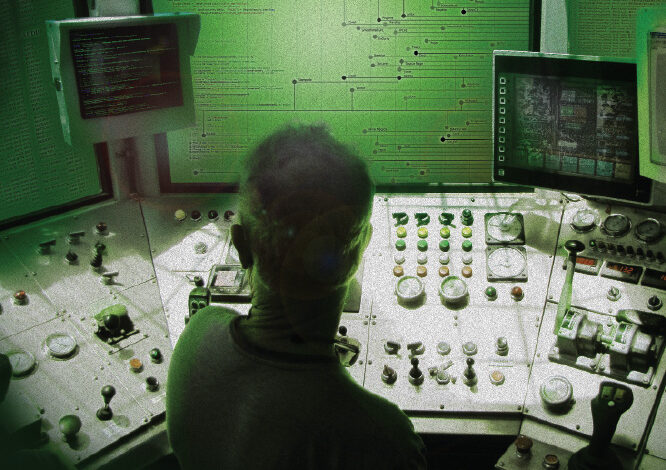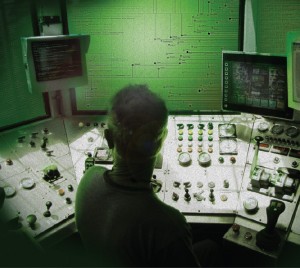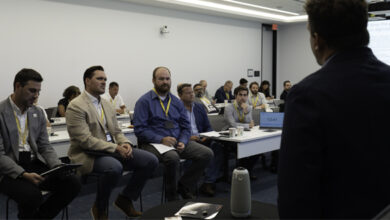Bridging the communications gap in rig automation

IADC Drilling Control Systems subcommittee, SPE DSATS group set out to create reference roadmap to achieve full rig automation, define communication protocols needed for downhole, surface integration.
By Linda Hsieh, managing editor
 When IADC held its first Advanced Rig Technology Conference in September 2009, the association’s Advanced Rig Technology (ART) Committee took the opportunity to poll attendees. Questions such as “Where is the biggest need for reliability improvement among rig equipment?” and “Where is the need for improvement in drilling control systems?” were asked.
When IADC held its first Advanced Rig Technology Conference in September 2009, the association’s Advanced Rig Technology (ART) Committee took the opportunity to poll attendees. Questions such as “Where is the biggest need for reliability improvement among rig equipment?” and “Where is the need for improvement in drilling control systems?” were asked.
The audience response to the latter question yielded a surprising result, said Terry Loftis, Transocean engineering manager – DP, instrumentation and controls. As vice chairman of the IADC Drilling Control Systems (DCS) Subcommittee, a subgroup of the ART Committee, Mr Loftis had been canvassing the industry to determine which initiatives his group should undertake.
When he saw that more than 35% of the audience – the largest percentage – selected “Integration with Downhole System,” he knew he had his answer. “It was a real eye-opener and was invaluable as far as telling us where we needed to put our efforts,” Mr Loftis said. Other options in that multiple-choice question were alarm management, information management, software revision control and uniformity of drilling control functions among manufacturers.
At the same time that the DCS Subcommittee found its new direction, an SPE group was moving almost in parallel. The SPE Drilling Systems Automation Technical Section (DSATS) got its start with a meeting at the 2008 IADC/SPE Drilling Conference in Orlando, Fla. The goal was to shift industry discussions of automation from simply mechanization (such as automated pipe handlers) to the downhole process, said Fred Florence, product champion for automation & drilling optimization at National Oilwell Varco (NOV). He is now deputy chairman of DSATS.
Since its formation, the group has primarily been working to generate awareness in the industry via meetings and technical papers. “It’s been showing people where the risks are, the values it would bring, and technically trying to identify the steps to take in order to progress,” Mr Florence said.
In April 2010, DSATS held a two-day workshop in Galveston, Texas, focusing on drilling automation. More than 120 people attended, including representatives of several major oil companies. Also there were members of the IADC DCS Subcommittee, who found themselves amongst a group of experts looking at many of the same things related to automation.
An exchange of ideas began between the two groups, and both are now looking at ways they could pool resources and knowledge to work toward a robust automation solution for the industry.
WHAT’S NEEDED?
When it comes to drilling automation, a primary obstacle is the lack of a common communication protocol and language that would allow multiple third-party companies to connect to and control drilling equipment on a rig.
Certainly, the industry isn’t starting from scratch. WITS (Wellsite Information Transfer Specification) is a data exchange protocol that’s been around since the 1980s. WITSML (Wellsite Information Transfer Standard Markup Language) is a web-based version of WITS that’s been around for years as well.
Yet neither WITS nor WITSML gives you automation. They provide a means for data transportation so that dissimilar data sets can be put together. Yet there’s still no control of the equipment involved. For automation to happen, there must be an element of control, and that’s where standards like OPC (Object Linking and Embedding for Process Control) come in.
OPC is not an energy industry standard but is widely used in other industries and has been around for many years. There are many such standards, but OPC is one that has found many supporting users in the drilling industry.
While the OPC specification takes us a step closer, another layer of control is needed on top of it in order to achieve real automation.
“You need some data model or language, such as Mud Pump 1 = ON, Mud Pump 2 = OFF, that is specific to our application in the drilling industry. The machines can talk through OPC, but you still have to give them a language,” Mr Florence said. “OPC is the phone line. We still need the right language to communicate, and that’s what we’re working on right now.”
For example, if we want a computer-generated model to command the top drive to increase or decrease torque, we can use the drillstring torque value measured at surface or, via MWD, downhole at the drill bit. There must be a specific instruction set for each command. The downhole torque – the measured data input – would be covered by WITS/WITSML, but the control aspect of the automation scenario would be communicated via OPC.
In a sense, it’s about helping all the various pieces of surface and downhole equipment to interface with one another. How these different protocols and languages like WITSML and OPC will be used in the drilling industry, whether they’re sufficient for our needs, is something that’s not clear-cut at this point.
“There may need to be a slight morphing of the WITS protocol to allow us to integrate those control features, and there may need to be a slight morphing of OPC to provide the data security aspects,” Mr Loftis said.
He stresses that his group is still in a very early stage of research. “We’ve already assembled a short list of technical solutions and a strong group of technical experts within DCS to help us define what it’s going to take to drive this new level of automation. That’s part of our remit, to define the drilling scenarios and tools involved and determine the most effective means to monitor and control all aspects of those operations,” he said.
“Our convictions are, yes, we can, and we’re prepared to run the gauntlet to back that up.”
COLLABORATION
As the two IADC and SPE groups begin their cooperative effort to advance automation, both Mr Loftis and Mr Florence made it clear that they’re not trying to create a standard but rather a guideline.
“We’re trying to present valuable information to the industry at large, as guidelines, for those who may be wondering what is best for their operations… We’re not in the position of creating a standard, but it will be a guideline with substantial validation if it has the IADC and SPE recommendation behind it,” Mr Loftis said.
He hopes it will be a reference document that the industry can use as a roadmap to achieve integration of surface and downhole equipment.
By interacting with the IADC DCS Subcommittee, Mr Florence said, DSATS hopes to create more awareness of the potential benefits of automation throughout the drilling contractor community. Their involvement and acceptance will be crucial before true closed-loop automation can be achieved, he said.
“These guys know their rigs inside out. Having them tell us what they need and how they want this integration to work is paramount,” Mr Florence said.
Each drilling contractor has its own drilling control philosophy, and industry groups need to take those philosophies into account. “As we build these controls, we have to make sure they fit in the environment of the rig and the rig personnel,” he continued.
And that is part of the input that the IADC DCS Subcommittee will attempt to provide in this collaborative effort, Mr Loftis agreed. “Within the IADC domain, we’ll be conferring with our constituents to ask, ‘What do you think about this from your company’s perspective?’ ”
Mr Loftis also acknowledged that there is still a certain level of caution about whether drilling contractors would really relinquish control of their equipment to a remote supervisory system or computational model. After all, it’s the drilling contractor who’s contracted to drill the well.
“But, to a certain degree, supervisory control’s already done today,” Mr Loftis said. For example, directional drillers instruct drilling contractors how to steer directional tools, and dynamic positioning systems are used to automatically hold drillships in place while a marine crew member supervises the performance. “Drilling automation is just one step beyond that, and I think it’s a natural progression. Although people might have reservations about it, I think ultimately that’s where the technology will lead us,” he said.
RELIABILITY
One significant concern that DSATS has identified as needing further work for drilling automation is reliability. Participants at the Galveston workshop emphasized they need to know that both the hardware and software will do what they’re supposed to do.
They pointed to problems in the past on rigs with drilling mechanization machines where initial reliability caused delays in shipyards. How will reliability be designed into the automation controls? Is there a process to check for reliability before going to the rig site? How will failures be detected? What diagnostics will be available from the machines and software?
These questions must all be addressed, Mr Florence said, although HIL (hardware-in-the-loop) testing and FMEAs (failure mode effects analyses) are increasingly being used to improve reliability and mitigate failure risks.
BUSINESS CASE
Outside of the technology itself, the commercial aspects of automation must be dealt with as well. Most operators see the efficiency gains and reductions in NPT that could be realized with automation, making currently uneconomic wells possible, while some service companies already have corporate business strategies based on automation, Mr Florence said.
It’s the business case for drilling contractors that may be a bigger hurdle, and Mr Florence believes that initially the effort will have to be fueled by operators seeking automation, just as they sought out top drives. Either that, or some contractors may build automation into their rigs because they recognize that it gives their fleet a competitive edge.
Because the IADC DCS Subcommittee is a technical group, they will not get into the commercial aspects of automation, Mr Loftis said. “We’ll look at the technical feasibility and how to accomplish it technically. Once we’re able to define a technical solution, I think those commercial issues will resolve themselves,” he said.
Shell leading industry forward with automation demonstration projects in Canada, Netherlands
By Linda Hsieh, managing editor
As the industry moves closer toward drilling automation, as exemplified by the work of industry groups such as IADC and SPE (see article on Page 24), there is one advantage to be enjoyed: We’re not the first or second ones to do this. Many other industries have already achieved high levels of automation, which should help to convince skeptics that it’s possible to adopt automation into the process of drilling oil & gas wells.
However, if examples from other industries are not convincing enough, maybe the demonstration projects being run by Shell will do the trick. The operator successfully completed a trial in Canada last year of automated remote directional drilling. The run focused more on automating the downhole process, by installing a computer on the rig that hooks into the rig’s control system.
They were able to let a machine do “what the driller would do,” said Mark Anderson, Shell drilling mechanics technologies manager. In some ways, this is not so new to the industry as several rig systems, like dynamic positioning, are already highly automated.
Shell is currently running another automation trial, this time with an onshore well in the Netherlands. Additional trials are planned for North America and China later this year. “The algorithms we’re running now in the Netherlands are already better than the ones we ran in Canada because we learned a lot and we have more intricate programming,” Mr Anderson said. When they get to the next batch of demonstration projects, “our algorithms will be even better and more sophisticated.”
Because these algorithms will be built based on a compilation of best practices and not based on limited human experience, they will be able to produce smoother wellbores and more consistent results than human directional drillers could.
“Say we have 10 rigs in north Louisiana, that’s a day and a night directional driller for each rig, so 20 directional drillers. If you rank those 20 directional drillers in terms of how good they are, one will be the best and one will be the most inexperienced and worst of the bunch,” Mr Anderson explained.
What Shell is after is the performance of that best directional driller and replicating that consistency across the whole fleet, at the same time avoiding the performance of those directional drillers at the lower end of the spectrum.
Reducing variation in the process of routine and repetitive tasks is the ultimate benefit, he said.
Additionally, with a machine taking over mundane tasks, each directional driller could supervise multiple directional-drilling rigs at once, leveraging that manpower, he continued.
The computer would not override any of the control systems on the different pieces of rig equipment involved, such as speed limits, crown savers and floor savers. It’s really not much different than the company man or toolpusher telling the driller what to do with the rig equipment, Mr Anderson believes. The difference is that a machine will determine the commands and execute it – more precisely and consistently than humans could.
The driller will stay on the drill floor and very much in control of the operation. A switch is built into the system that the driller could flip to immediately resume control of the system, Mr Anderson explained.
He adds that he has followed and supported the work of the SPE DSATS group and will continue to. However, while that effort is going on, he thinks the time is ripe for the industry to simply go out and do automation.
There was a lot of discussion at the Galveston workshop about the myriad of automation communication protocols available and which would be best for the drilling industry, he recalled.
Rather than wait for that consensus, Shell has selected one (OPC UA) and run with it. “We know the protocol language we’re going to use, and we have major vendors onboard. We’re just going to go out and do it.”
He hopes that Shell’s demonstration projects will help others in the industry to gain confidence in the feasibility of automation, and maybe see that this isn’t science fiction or even something that’s decades away.
“When you explain to people our intent, they nod their heads. But then many individuals’ eyes glaze over because they can’t picture that it’s possible. After all, how can a computer take over many of the tasks currently performed by a human driller? So we’re doing these demonstration projects to show people what is possible and to learn ourselves,” Mr Anderson said.
“We are going to be an early adopter, and we would like to work with like-minded drilling contractors and service companies.”
As a general rule, humans don’t like change. But, like it or not, change is also inevitable.
“There’s going to be a business model change,” Mr Anderson said. “I believe that drilling contractors and service companies have the ability to gain or lose because of a changing business… but the rigs you’re going to see in five years’ time are going to be controlled differently.”





I was at an OPC Foundation seminar last year, OPC UA was not released yet. Curious to know how long Shell has used it.